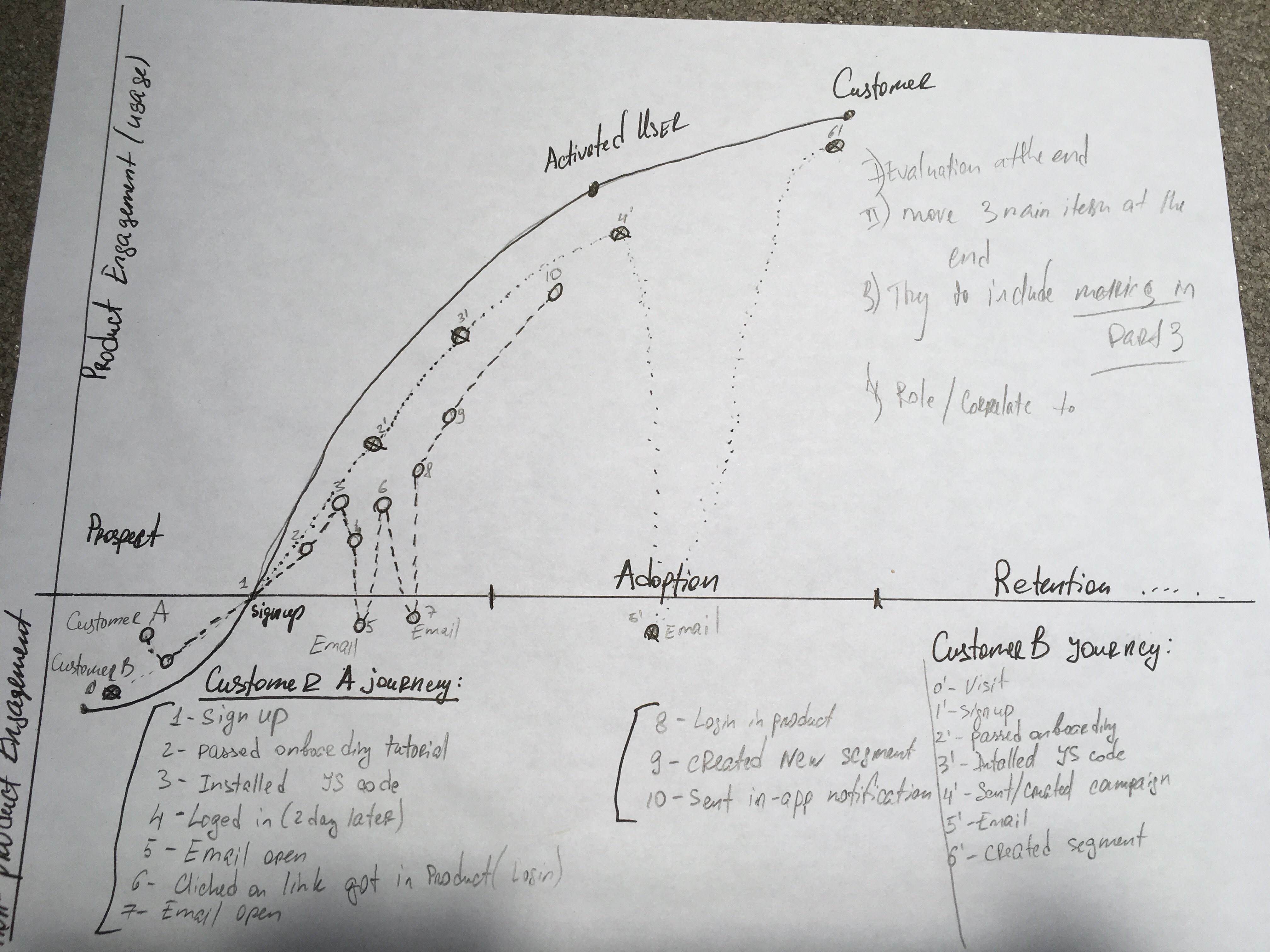The Ultimate Thought Leadership: How To Write an Industry ‘How-to’ Book
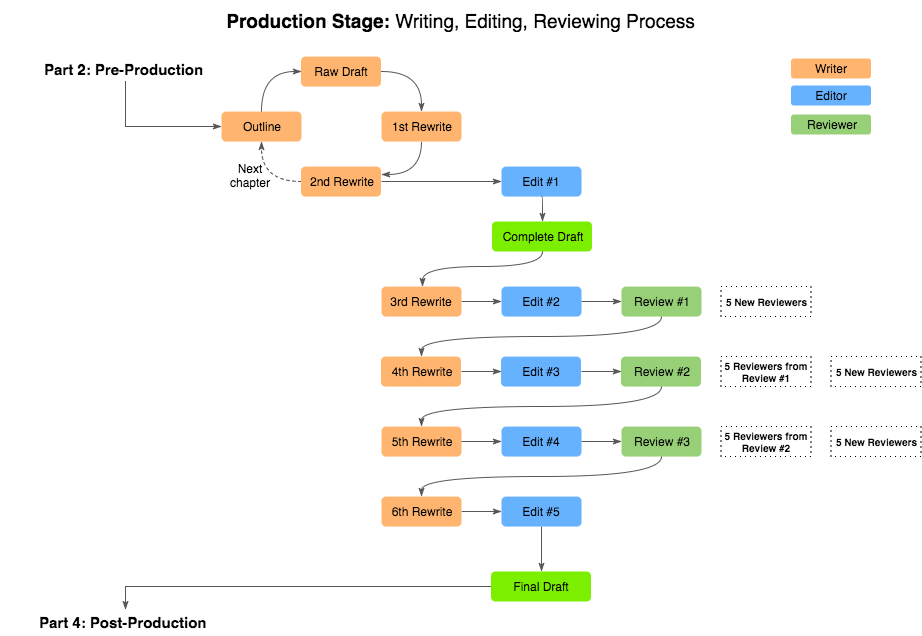
Process, Tips, Hacks, Resources...
Table of Contents
Introduction
Part 1: Development: Why, Who, and What?
- Start with Why: Why are you writing the book? / why do you want to write a book?
- Know Your Reader: Who are your readers? Who are you writing for?
- Select Your Topic: What are you writing about? What is the main topic?
- Create a One Sentence Summary (story)
- Research your readers, industry trends, books, articles
5.1. Where to Search for Resources
5.2. Catalogue Resources
5.3. Relevance & Reliability
Part 2: Pre-production: Creating a Storyline
- Outline and Organization
- Examples, frameworks, diagrams
7.1 Examples
7.2. Frameworks
7.3 Diagrams / Figures - Style
Part 3: Production: Writing Process
- Writing Process (tips and hacks)
9.1. How to become more efficient and effective in writing
9.2. How to improve your writing - Review and editing process
Part 4: Post-Production: Design & Layout
- Finalizing title, chapter titles, etc.
- Designs and Visuals
- Final reviews
- Layout (Digital / Print)
- Hard Copy
Part 5: Distribution (and Promotion)
Summary
Introduction
How do you build a successful SaaS brand? The answer seems quite obvious when you look at industry leaders. They build brands by producing and distributing great content.
Today, every company — even SaaS — is a media company because content is often the first interaction a prospect has with a company. To reach and engage their target audience, every company must have a content strategy incorporating different types of content (text, visual, audio, video) and multiple channels and platforms.
But it can’t be just any content. After all, every company’s content is in a battle to grab and keep the attention of time-starved prospects. To truly stand out — and establish the company and its executives as thought leaders —, it must be informative and helpful, and, ideally, offer a fresh perspective. More and more companies are seeking to establish and cement their thought leadership by publishing a book that positions them as industry leaders. It’s the ultimate in thought leadership content.
The goal of this article is to guide you through the process of writing and publishing an industry ‘how-to’ book. The strategies and tactics described here were tried and tested during a six-month long process of writing such a book. The final product was Mastering Product Experience in SaaS: How To Deliver Personalized Customer Experience with Product-led Go-To-Market Strategy (co-authored with Aptrinsic co-founders Nick Bonfiglio and Mickey Alon). It was an incredibly challenging and time-consuming process. This article compiles many ideas, strategies, tactics, and techniques that I wish I knew prior to starting my work on the book.
Use your founding story as a launch point
While you can write a book at any stage of your company’s existence, starting a company can be a terrific catalyst for your book. After all, to launch a company, you need to sell a vision, a new way of thinking about a problem. A book is a great way to share the founder’s vision with the rest of the world.
Jon Miller, who co-founded Marketer and later co-founded Engagio, which provides an account-based marketing solution, has published a few industry books, including The Clear & Complete Guide to Account Based Marketing. The co-founders of Hubspot, a marketing automation company, popularized the term inbound marketing and literally wrote two books on it. The first was Inbound Marketing: Get Found Using Google, Social Media, and Blogs. The more recent version is Inbound Marketing: Attract, Engage, and Delight Customers Online.
There are many examples of industry books. Personally, I have learned a lot by reading:
- The Ultimate Startup Guide to Outbound Sales by Steli Efti (CEO of Close.io)
- Hacking Sales by Max Altschuler
- The Blueprints for a SaaS Sales Organization by Jacco Van Der Kooji
- The Sales Acceleration Formula by Mark Roberge
- Customer Success by Nick Mehta, Dan Steinman (both from Gainsight), and consultant Lincoln Murphy
- Survival to Thrival by Bob Tinker, Tae Hea Nahm with Fernando Pizarro
Avoid these common pitfalls
Search for “business book” on Amazon.com and you’ll see more than 2,000,000 results. However, many business books fail to generate awareness and interest. Here are a few reasons why companies fail to succeed when publishing an industry book:
Content is too basic
You have to know your target audience and their level of expertise. An industry book has to be educational. If the content is too basic,readers won’t get much value from it. In the world where content is everywhere, it pays to go deep.
Content is too promotional
The purpose of an industry book is thought leadership through education. It’s not supposed to be an advertisement. While it is okay to include examples from your company, no one wants to be sold on every other page.
Content is too boring and dry
Educational content can be a bit boring and dry. In addition to writing with personality, it helps to incorporate plenty of real-world examples, frameworks, and visuals.
Distribution failure
Even great content has to be found by the target audience. Publishing a book takes a lot of time and effort. Don’t let it go to waste because of an ineffective (or non-existent) distribution strategy.
Start with a proven framework
Based on my experience, writing a decent book takes about six months. It can be overwhelming to work through the process without a solid plan. I believe the process of creating and launching a movie offers a great framework to follow, divided into five stages: development, pre-production, production, post-production and distribution.
The table below shows how your time putting together a book gets broken down into the five stages.
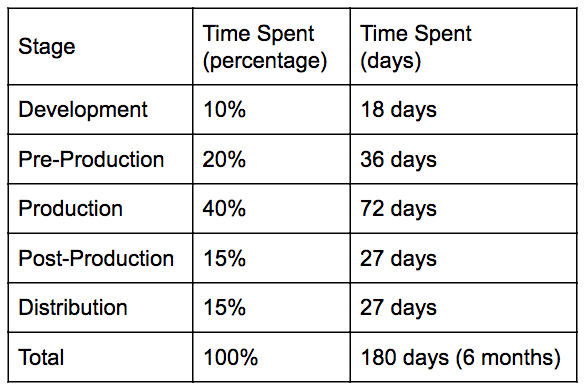
Let’s get started...
Part 1: Development: Why, Who, What, and How
“Either write something worth reading or do something worth writing about.” Ben Franklin
1. Start with Why: Why are you writing a book?
The key to publishing a popular industry book is quality of content and effective distribution. But before you start any writing, figure out why you want to write a book. The book is an opportunity to share expertise and experiences, explain a new trend, shed a light on research findings, build a personal brand, or even introduce a new strategy. Above all, writing a book is a chance to tell a coherent and engaging story while contributing meaningful ideas, strategies, and tactics to your industry.
Since we are discussing an industry how-to book, the goal of making money with a bestseller is out of the question. It’s unlikely that your industry how-to book will generate any meaningful profit from direct sales. In fact, most industry how-to books are distributed for free or at a breakeven price. It’s even challenging to draw a direct correlation between the success of your book and product sales.
A more realistic reason and payoff for writing an industry how-to book is to build a personal and company brand. While a good book will positively affect both, this alone is not a good reason to spend many hours sweating over the manuscript. While your company might not make sales in the near term, you will likely drive sales in the long term by building a strong brand.
Let’s put aside the goal of building brand awareness and look a few levels deeper at the underlying reason(s) you are writing a book. Answer the following questions honestly:
- Do you have something unique to share?
- Is there an interesting and surprising angle that most professionals in your industry overlook?
- Do you know an effective strategy or tactic that you can share with the world?
You must answer YES to at least to one of these questions to write anything worth reading. The desire to build your brand won’t get you through the grueling process of writing a book and won’t produce a quality result.
When I and co-founders of Aptrinsic (Nick Bonfiglio and Mickey Alon) were writing the Mastering Product Experience in SaaS book, our goals were two-fold. We wanted to explain a new trend, and outline effective strategies and tactics for how SaaS professionals can build better products. Sure, we wanted to introduce Aptrinsic to the industry and justify the company vision. But at the end of the day, it wasn’t the primary reason we decided to write the book.
Quite frankly, the goal of building a personal and company brand wasn’t a powerful motivator during the most difficult periods of writing. What motivated me the most throughout the six-month process was the fact that we were contributing a unique perspective to the industry. The main goal was to create something helpful and the ultimate reward is knowing that readers not only enjoyed reading the book but also intend to implement strategies and tactics that we shared in it.
By helping and educating your readers, you build the brand indirectly. So the why should be all about your readers, and branding is a nice outcome.
Remember: Your readers will invest one the most precious resources at their disposal: time. Think about the last time you saw a bad movie. If you are anything like me, you feel utterly disappointed wasting two hours of your life on a subpar product. So before you put pen to paper -- or words on a screen -- you need to figure out if you can deliver a book that your readers will feel was a good investment of their time.
Start with why: Why do you want to write a book? And when answering this question, focus on your readers rather than on yourself or your company.
Tips: Start With Why is a bestseller written by Simon Sinek. It describes how the most successful companies inspire by answering why they do what they do.
2. Know Your Reader: Who are your readers? Who are you writing for?
With the why question answered, it’s time to clarify who you are writing for. The trick is picking a broad enough audience to justify your time writing the book but targeted enough to ensure that your readers derive sufficient value.
Most of the books that you buy and read are likely intended for mass audiences. Even psychology books such as Thinking Fast and Slow by Daniel Kahneman or Predictably Irrational by Dan Ariely are written in a way that almost everyone can understand. The topics are relevant to everyone and the writing style makes it easy to comprehend sometimes difficult ideas and theories. However, the audience of an industry how-to book is much narrower.
With Mastering Product Experience in SaaS, we focused on the SaaS industry as the broad audience. On a more granular level, we focused on leadership and functional teams (marketing, sales, product, and customer success) that influence the go-to-market strategy.
Once you clearly define your audience down to their role(s), you must be able to make the book appealing to professionals with different levels of expertise and experience.
What can be new and interesting to a recent marketing grad might be boring and banal to someone with 20 years of industry experience. However, if you skip basic concepts and definitions and assume that your readers already possess this knowledge, you risk creating an incoherent story that’s difficult to follow. Even someone with tons of industry experience will find it difficult to understand what premises led to your conclusion(s). As a result, the validity of your arguments can suffer. Your main story should be sufficiently supported with examples, evidence, and whenever possible, based on well-known facts.
Striking a balance between fundamental knowledge and less obvious concepts and conclusions will help you write a book that’s a worthwhile read for a recent grad as well as for an executive with twenty years of experience. Before you sit down to write the book, it helps to gauge how well you can strike that balance. Prior to my work on the Aptrinsic book, I wrote a few long in-depth research articles that generated over 200,000 views on Medium. Here’s how I evaluated the success of my articles -- it’s a helpful formula you can apply to test your book content.
I divide the target audience based on their level of experience and identify specific goals and takeaways I would like them to achieve.
1. Limited Experience (low expertise) - 0-5 years of industry experience
Goals / Takeaways: Ideally, people with this level of experience should find 60%-80% of the content new, educational, or helpful.
2. Medium Experience (medium expertise) - 5-12 years of industry experience
Goals / Takeaways: Readers with this level of experience should find some of their ideas confirmed or challenged but find at least 20% of your content educational or new.
3. Highly Experienced (high expertise) - 12+ years of industry experience
Goals / Takeaways: Ideally, professionals and executives with 12+ years of experience should find at least one idea or concept worth testing. If an industry expert or high-level executive finds at least one idea or concept worth testing, it is a successful piece of content in my book.
Tip: Mentioning multiple resources and references will help your audience -- especially those with less industry experience -- develop fundamental knowledge while not boring or alienating readers with more expertise. Define, summarize, and provide resources so less experienced readers can get up to speed.
My approach targeting different levels of expertise and experience works for my articles and it seemed to work for the book. That said, you may want to narrow your target, such as to newbies or experienced leaders. It all depends on your main target audience.
Of course, what we attribute to professional experience is highly subjective. In fact,experience does not necessarily equal expertise. There are plenty of examples of professionals with more expertise and less experience, and vise versa. Expertise correlates with the individual capacity to learn, motivation to excel professionally, and personal grit, among other factors.
To cover all our bases and accommodate this subjectivity, this is how we thought about the audience for our book:
Target Market: SaaS industry
Functional teams: Marketing, Sales, Product, and Customer Success
Experience level: Inexperienced, medium experience, highly experienced
Perhaps you’re thinking “Why go through the exercise of figuring out what will appeal to different audiences if you end up targeting all possible audiences?” It’s still a worthwhile exercise because it will help you determine whether or not you are including the right mix of information and ideas in your book.
Who you are writing for and what you want your readers to take away is as important as why you are writing a book. Documenting your target audience(s) and the key takeaways you have in mind for them will inform your book’s topic and story.
3. Select Your Topic: What are you writing about? What is the main topic?
The idea to write an industry book usually starts with the topic. However, fight your urge to jump to the topic right away. Hopefully, it’s clear by now that why you are writing and for whom are critical questions you should answer before you start developing your topic.
The topic of the book is not the same as the book title. (In fact, you should write the title once you are finished writing the book, as you can best capture the theme once you’ve been immersed in it.) The topic is a subject you will cover.
The original topic for our book was “a product-led go-to-market strategy as a catalyst for SaaS success in the customer experience era.”
While you want the book title to convey the main theme, it’s designed to capture attention. Though it’s common for books to feature provocative titles, a descriptive title might be your best bet for an industry book. You want your target audience to quickly be able to determine whether or not the book is intended for and relevant to them.
So far,we’ve covered the three main questions that you need to answer before starting to write:
- Why are you writing a book?
- Who are your writing for? Who is your primary audience?
- What are you writing about?
The rest of this article will focus on the last and largest question: how.
4. Write a One-Sentence Summary
“A thesis statement is the main idea of a piece of writing, its focus.” - from The Bedford Reader
Think about describing a movie or a book to a friend. Instinctively, you want to evoke interest but not give away too much of the story. The most effective descriptions hint at the direction of the narrative without any spoilers. You can apply this concept to your book with one-sentence summary. Think of it as pitching your story.
The best pitches are short, simple, and descriptive. A pitch helps you, as writer, stay on track in your writing and helps your reader decide whether or not they want to read your book. A one-sentence summary should spark interest. It’s an elevator pitch, if you will.
For great examples of one-sentence summaries, check out your favorite movies on IMDB. Here are a few examples that caught my eye:
Pulp Fiction (1994): The lives of two mob hitmen, a boxer, a gangster's wife, and a pair of diner bandits intertwine in four tales of violence and redemption.
American Beauty (1999): A sexually frustrated suburban father has a midlife crisis after becoming infatuated with his daughter's best friend.
Avatar (2009): A paraplegic marine dispatched to the moon Pandora on a unique mission becomes torn between following his orders and protecting the world he feels is his home.
Matrix (1999): A computer hacker learns from mysterious rebels about the true nature of his reality and his role in the war against its controllers.
A summary of your ‘how-to’ story will guide your outline and narrative. Obviously, your how-to book won’t have a main character. But in one sentence, you should be able to explain the book’s topic, target audience, and why anyone would read it -- what you want your reader to learn. To break it down, your one-sentence summary should include:
- Topic: Tell what the book is about
- Target Audience: Identify the audience
- Takeaways: Explain what the reader will learn
A how-to industry book is unique when compared to movies or fiction. The primary purpose of ahow-to book is to educate your readers, teach them something, or explain a new or unique concept, while fiction is more focused on entertaining the audience. Certainly, you can learn a great deal from literature and films, but it isn’t their primary goal.
You will use your one-sentence description to:
- Pitch your book to potential readers early in the process to test market interest
- Guide your industry research and stay on track while writing
- Create a book outline
Here’s an example one-sentence description of our book, Mastering Product Experience in SaaS:
The book explains why SaaS companies must focus on customer experience and how to deliver a personalized customer experience with a product-led go-to-market strategy.
Topic: Personalizing the customer experience with a product-led go-to-market strategy
Audience: SaaS industry professionals
Takeaways: Product-led go-to-market strategy effective in personalizing the customer experience
Note: You should write your one-sentence description before you write your book title and your book. That said, you will likely update it during the last stages of developing your book because you can better crystallize the description once you've written the book.
Tips: Check out the insightful writing on messaging and story creation by Andy Raskin.
5. Research your readers, industry trends, books, and articles
The person who writes an industry how-to book should possess a significant amount of relevant knowledge and experience. Yet, even with a deep knowledge, extensive research into f the topic and audience brings opportunities to find the right angle, supporting evidence, and a consistent and compelling voice/tone.
Some would argue that it’s more helpful to conduct research after creating the outline is created (we will discuss the outline in the next section). The truth is that you will likely be conducting research throughout the writing process. In my experience, it’s more effective to kick off the research phase prior to creating a tentative outline. Your research will inform your outline, so starting with research helps prevent any major late-stage changes to your narrative.
Researching first naturally allows you to more broadly consider the topic rather than be boxed into specific narratives by the outline. It allows you to understand the industry from the 10,000-foot view. This makes it easier to spot large themes, like prevailing industry paradigms (or conventional wisdom).
The research goal is to understand the industry and the topic from a big-picture perspective. Overvaluing a particular point or idea or even an industry consensus might negatively impact your own creativity or predetermine your arguments. The research should be a neutral assessment based on objective observation. Later, when you start designing your outline and drafting the book, you will need to critically examine your sources.
5.1. Where to Search for Resources
Thankfully we are living in an era when information is easily accessible online. Today, the biggest challenge is not finding information but analyzing its credibility, validity and relevancy. More on this later. For now, let’s look into where to start your research.
1. Identify related books
Because the writer should possess significant industry knowledge, so it shouldn’t be hard putting together a short list. You can always ask your network or industry experts to point you in the right direction. During the writing of the Mastering Product Experience in SaaS book, I read at least 15 related books: Selling the Invisible, Play Bigger, Sense and Respond, and Marketing Imagination, among others. All of them contributed to the quality of the final product.
2. Find industry influencers
Industry experts can be great sources of wisdom. Find out what they read, what they share, what they write. If you have the opportunity, interview them about the industry in general and later in the writing process you can reach out and ask them for comments or reviews.
3. Scientific research
Scientific research will bring credibility to your writing and enhance your story with statistics. McKinsey, Boston Consulting Group, and Marketing Science journal were my top destinations to find relevant studies and supporting materials. After reading How Brands Grow, I added Ehrenberg-Bass Institute to my list of resources.
Industry research companies like Forrester, Gartner, and IDC can be resourceful but you often need to pay sizeable sums for their best reports. Also, because these companies cater to large organizations, they are unlikely to identify early trends. If you are writing about an interesting new strategy or trend, don’t expect to find tons of supporting materials from these resources. However, their surveys, for good or bad, represent an industry consensus, which is good to keep in mind.
A short list of resources:
- McKinsey
- BCG
- Marketing Science Journal
- Forrester
- Gartner
- IDC
4. Newsletters
You can find newsletters covering just about any niche. The startup, tech, and SaaS communities are catered to by a great list of well-curated newsletters: Mattermark, Founders Grid, Growth Hackers, Openview Labs, First Round Capital, and Grow.co, to name a few. I’m certain that most industries are served by relevant newsletters. Subscribe to them and search their archives. Not every good resources is easy to find in Google Search. Some great ideas come from lesser known sources that do not use standard keywords or jargon.
5. Publications: Articles/Blogs
Search for articles, blogs and related publications.
6. Communities: Quora, Reddit, Growth Hackers
For years, I have been saying that Quora is probably one of the most underutilized social media platforms by those in the SaaS industry. Quora provides great insights into your target audience’s concerns and related questions. When you get to the book distribution phase, Quora is a powerful resource for sharing detailed information on questions related to your book topic (follow me on Quora). Reddit and Growth Hackers are good communities to understand what people in the industry are reading and what questions come up frequently.
7. Interview the target audience
Just as interviewing your prospects is a great way to improve your product, interviewing your potential readers can unlock resources and ideas that you otherwise would not have found. You can identify these people by calling upon the research you (or someone in your company) conducted to define your ideal customer profile.
5.2. Catalogue Resources
Creating a simple spreadsheet with all these resources so you have them at your fingertips. You will be writing for months so it’s quite likely that you will forget where you read about a particular idea or example. Trying to track it down again can take hours. Here are tactics to help you manage the resources in your spreadsheet:
-
One-sentence summary. Summarize what the article is about, the main idea.
-
Tag or separate each resource based on the topic or idea. For example, I created separate sheets for resources about onboarding, customer lifecycle, go-to-market strategy, SaaS metrics and others. If you can’t remember a particular resource, searching a specific category will save you valuable time during the writing process.
-
List authors’ social media profiles (Twitter/Linkedin) to connect later. You might need to reach out to them to get their perspective or share your book, especially if you reference their work.
5.3. Relevance & Reliability
During the research phase you will probably find hundreds of related resources. While writing Mastering Product Experience in SaaS, I maintained a spreadsheet with over 300 links to articles, research papers, videos, blogs and other resources. The final version of the book included about ninety sources.
Your sources will enhance your writing only if they are relevant and reliable. To analyze their relevance and reliability, ask the following questions about the main idea and evidence, the author’s credentials and expertise, and the source’s target audience:
- Does the article/report/content support my book narrative? What is the main point of the material?
- Who is the intended audience for the publication or resources? Does it match our target audience?
- What kind of supporting evidence does the author use in his or her writing?
- Is the author an expert in this subject? What kind of relevant experience does he or she have?
Your resource spreadsheet will be the base for your writing process. As you move from research to outlining and then to writing, you will have to analyze, infer, and evaluate the strength of the arguments presented as well as the credibility of the authors.
Part 2: Pre-production: Creating a Storyline
6. Outline and Organization
“Be specific enough to be believable, but universal enough to be credible.” - Ann Handley, author of Everybody Writes
Your one-sentence description summarizes the main idea for the whole book. When you create the outline, you break down the main idea into meaningful pieces that will form chapters and sections. Remember that how-to content always describes a process for achieving something.
Think of a cookbook with recipes that explain a step-by-step process for preparing a dish. It has to be clear and detailed enough for the first-time reader to follow in order to achieve a somewhat predictable outcome. You want to achieve the same goal with your how-to industry book: the process has to be clear and detailed enough for readers to achieve certain outcomes.
The outline is also the time to think about the substance of the story. Good writing starts strong and piques curiosity. Informative and exciting writing creates a gap between the current state and common understanding and the “promised land.” In other words, it paints an appealing and compelling alternative that readers can harness by shifting their current beliefs or by using a specific process to get there.
Break your main idea into smaller topics by raising questions
The best way to kick off the brainstorming process is to write out the main idea you want your readers to take away. Then break it down in whys and hows.
For example, the main idea in our Mastering Product Experience in SaaS book is that a product-led go-to-market strategy is the most effective way for SaaS companies to deliver a personalized customer experience. Let’s deconstruct this main idea with follow-up questions:
- Why is it important for SaaS companies to focus on customer experience?
- What is the current state of the SaaS industry?
- How is the industry changing?
- What is a customer experience?
- How must companies change to achieve success in the new environment (the promised land)?
- What are the best strategies and tactics to reach success?
- What are the takeaways for the readers?
These questions are quite universal regardless of the topic of the book. Some of them can be answered in just one sentence, while others will require a few sentences. For example, the industry can change in two or three distinct ways. The same is true for the question of how companies must change to achieve success. By answering these questions you should end up with 12-20 concepts to address in your book.
Create an outline using Post-it notes
There’s more than one approach to create an outline. However, I found it helpful to first deconstruct the book’s main idea into discrete, logical pieces. Then I put these ideas on Post-it notes and rearranged them until the best storyline emerged.
The picture below shows one of the earliest outlines for our Mastering Product Experience in SaaS book. It is worth noting that an outline can drastically change once you start writing and figure out that some concepts are not as important as others.
The dark red (crimson) colored Post-it notes represent chapters or major sections of the book.
The blue Post-it notes represent sections or ideas that are equal in importance.
The yellow Post-it notes show individual concepts for a particular chapter or section.
The pink Post-it notes highlight potential examples.
The Post-it notes with other colors show ideas that do not yet fit anywhere in the outline.
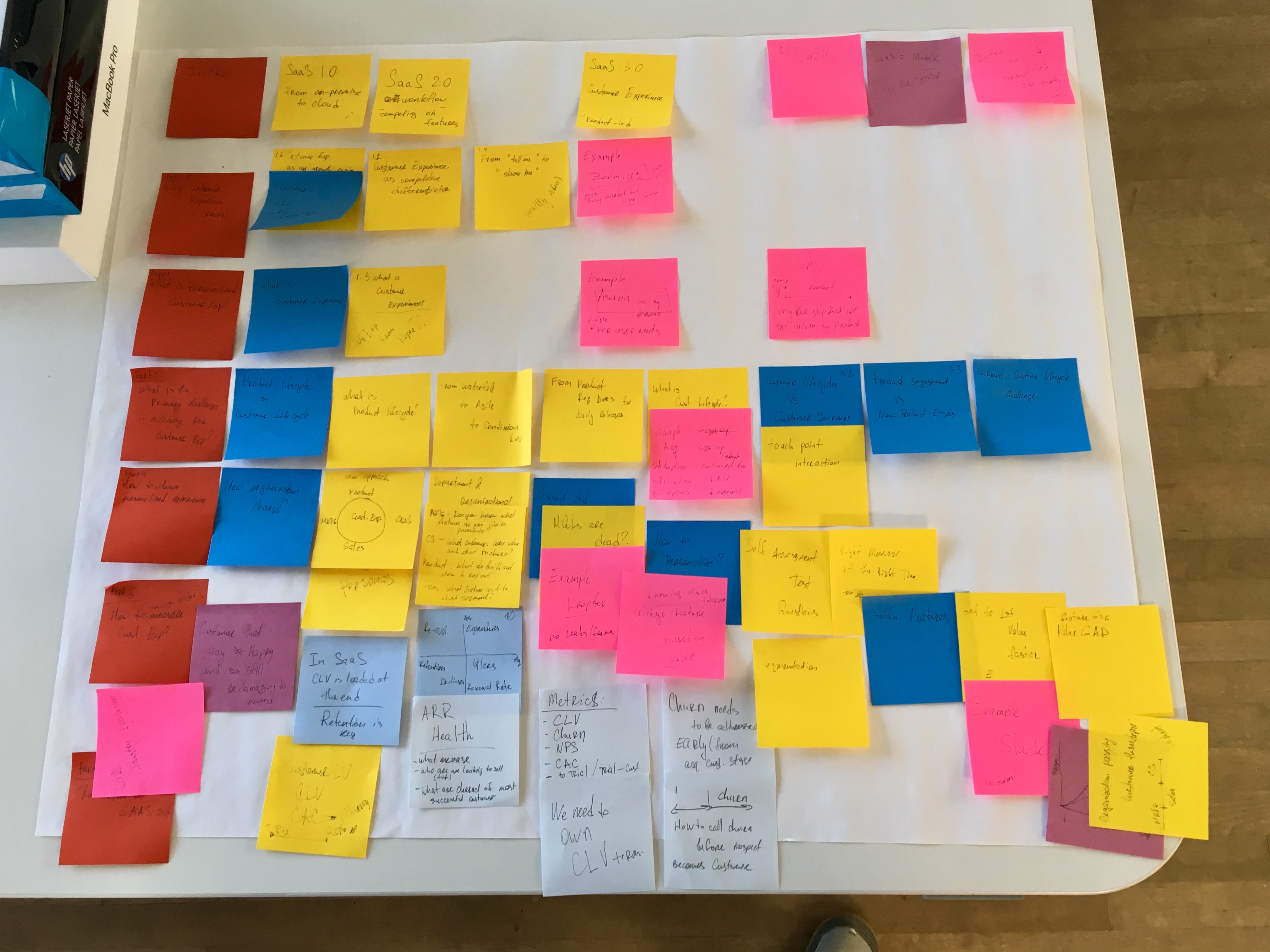
Present your outline
Presenting your outline orally can be tremendously helpful. Forcing yourself to just one sentence per each item (or Post-it) in the outline can be a powerful strategy to stay focused on the big-picture story. Even if you just lock yourself in a room and talk through the outline aloud, you will catch some initial problems and gaps in the story. Presenting your outline to someone else will give you instant feedback about the topic and flow and how the audience perceives your story.
Write one sentence for each item in your outline
The Post-it notes are a great visual aid and after a few presentations, you will be able to write one sentence for each idea or section represented in the Post-it notes. From one sentence that describes the main idea of the book, you move down and create similar one-sentence thesis statements describing the main idea for each chapter or section.
Start strong, build curiosity
When creating your outline, find strong reasons why readers should read your book and plan to address them early in the book. Pique curiosity using a combination of the following:
- Show the gap in the understanding between the conventional and a more successful strategy
- Tease with mention of the “promised land”
- Explain how a big and undeniable change affects the industry
Notice patterns
Some ideas will be related to one another. After presenting and rearranging your outline with Post-it notes, your narrative will eventually gravitate toward the most optimal storyline. Since we are attuned to hearing stories, presenting your book outline is a effective way to evaluate your story. Our ears are better trained to recognize stories than our eyes, simply because we do most of our communication in conversations.
Evolve your outline to show book parts and chapters
Most business books include between two and five parts and between ten and fifteen chapters. After you present an outline a few times and record the main ideas in one sentence each, it’s easier to divide the outline into book parts and chapters.
How do you know when your outline is good enough to start writing? An outline should be easy to present and easy to follow. The parts and chapters should be clear. Every part and chapter should include a couple of sentences describing the main theme and points. Even better if you create bullet points showing what content will go in each chapter. An outline provides placeholders for specific examples, visual diagrams, figures, tables, and frameworks.
Tips:
- Use Post-it notes for the storyboard and outline
- Let your ideas brew
- Use bullet points and lists
7. Examples, frameworks, diagrams
7.1 Examples
A book will be dull and boring without examples. Reading dry writing is not fun, even if it’s educational and beneficial. Examples help readers better understand concepts and provide a healthy dose of entertainment.
To incorporate examples, research companies and industry experts that do exceptionally well because they have already embraced the ideas you are presenting in the book. Interview influencers and industry experts for interesting experiences that fit the narrative. If this isn’t possible, you may be able infer lots of information by using a specific product or signing up for a service.
Examples morph abstract concepts and strategies into more concrete understanding. The Bedford Reader highlights four criteria for evaluating examples:
- Generalization: Is it clear to the reader what general statement an example illustrates?
- Support: Are your examples good enough to establish the connection with the general idea?
- Specifics: How detailed are your examples?
- Relevance: Does your example closely relate to the idea it illustrates?
Here are ways to incorporate examples into your ‘how-to’ book.
Point out failures
Loss aversion is a powerful motivator. Examples of companies, products, and strategies that failed because they were based on an outdated way of thinking can effectively draw readers’ attention. Nobody wants to fail and knowing how to avoid a costly mistake will be a motivator to continue reading.
Be prudent by selecting negative examples that won’t turn off your audiences. In Mastering Product Experience in SaaS, our examples of failing strategies are companies that are either no longer in business — e.g., Borders and Blockbuster Video — or outside of our industry — Monster and the hotel industry. An Amazon vs. Borders comparison might be overused in the industry. But it draws a clear picture of why the customer experience is critical to company survival and how digital transformation enabled new ways to serve customers.
Show success stories
A how-to book will describe a “promised land” and the strategies to get there, so including successful, well-known industry examples prevents ideas from being misunderstood or wrongly applied. Moveover, your book can benefit by associating it with a strong and successful brand in the industry. Plus, it’s an opportunity to reach out to the company you mention and request an interview or for help promoting the book when it is released.
In some cases, you can use a single company or industry example across the whole book. If you go that route, avoid using your company as the example, unless it is an amazing brand with a proven track record of success. Otherwise, you risk alienating readers with what might feel like a thinly veiled attempt to sell your product or service. We are talking about an industry how-to book.If your company has been that successful, you might be better off writing an informative ‘memoir’ similar to Shoe Dog by Phil Knight, Losing My Virginity by Richard Branson, Behind The Clod by Marc Benioff, Delivering Happiness by Tony Hsieh, Made in America by Sam Walton, and others.
Incorporate examples in every chapter and section
Difficulty finding examples should not prevent you from incorporating at least one example in each chapter and each section of the book. While meat and pasta a the core ingredients for lasagna, salt, pepper, spices and sauce are important for creating a fully flavored dish. Similarly, examples, diagrams, and frameworks are essential to creating a compelling narrative.
Examples make your writing more interesting, and can often explain a concept or idea better than a description can. They also help avoid misunderstanding, and improve comprehension and memorability by illustrating a generalization or a concept.
7.2. Frameworks
Regardless of how many ridiculous frameworks are flooding the industry, it is still a good idea to design a new one or to build on top of a popular industry framework. Frameworks provide a structured and systematic way to apply an idea or test a concept.
Framework is defined as a basic structure underlying a system, concept, or text. They explain step by step how to achieve a particular result by following a sequence of actions.
One of the main advantages in using an imperfect framework vs. using nothing at all is the ability to explain a concept in an easy-to-follow, easy-to-remember way. Frameworks ensure repeatability of what you are describing. Even a simple checklist can reduce the number of errors in a very simple process (explained by Atul Gawande in The Checklist Manifesto).
In Mastering Product Experience in SaaS, we created a number of frameworks to tell the story. First, we introduced the customer lifecycle as a better approach for evaluating the customer acquisition process of attracting, converting, and retaining customers. The SaaS and enterprise software industry are more focused on sales processes than on the buying process. A customer lifecycle is a core framework to understand the path a prospect takes to discover, try, buy, and renew a SaaS product.
Early drawing of customer lifecycle
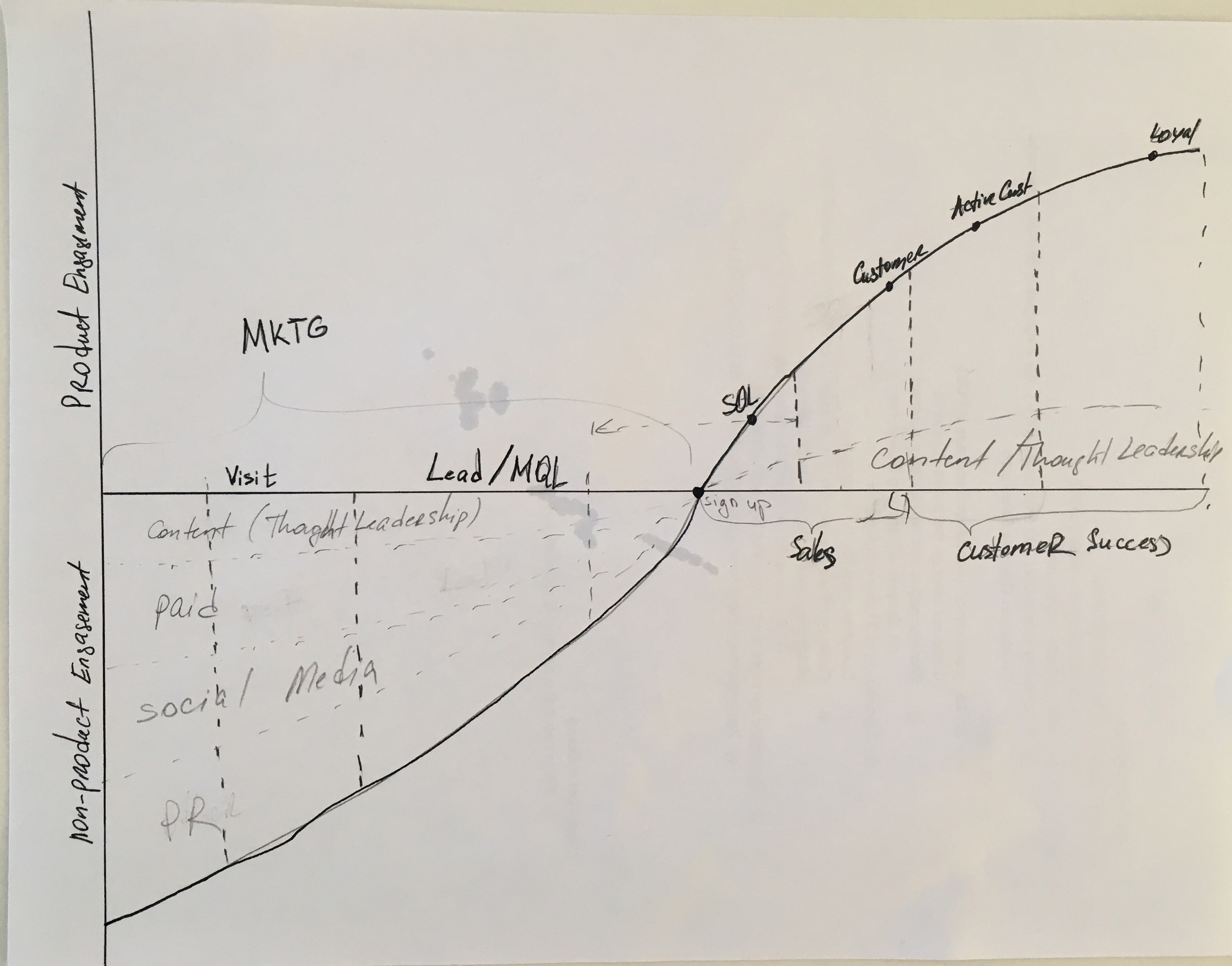
More fleshed out customer lifecycle framework
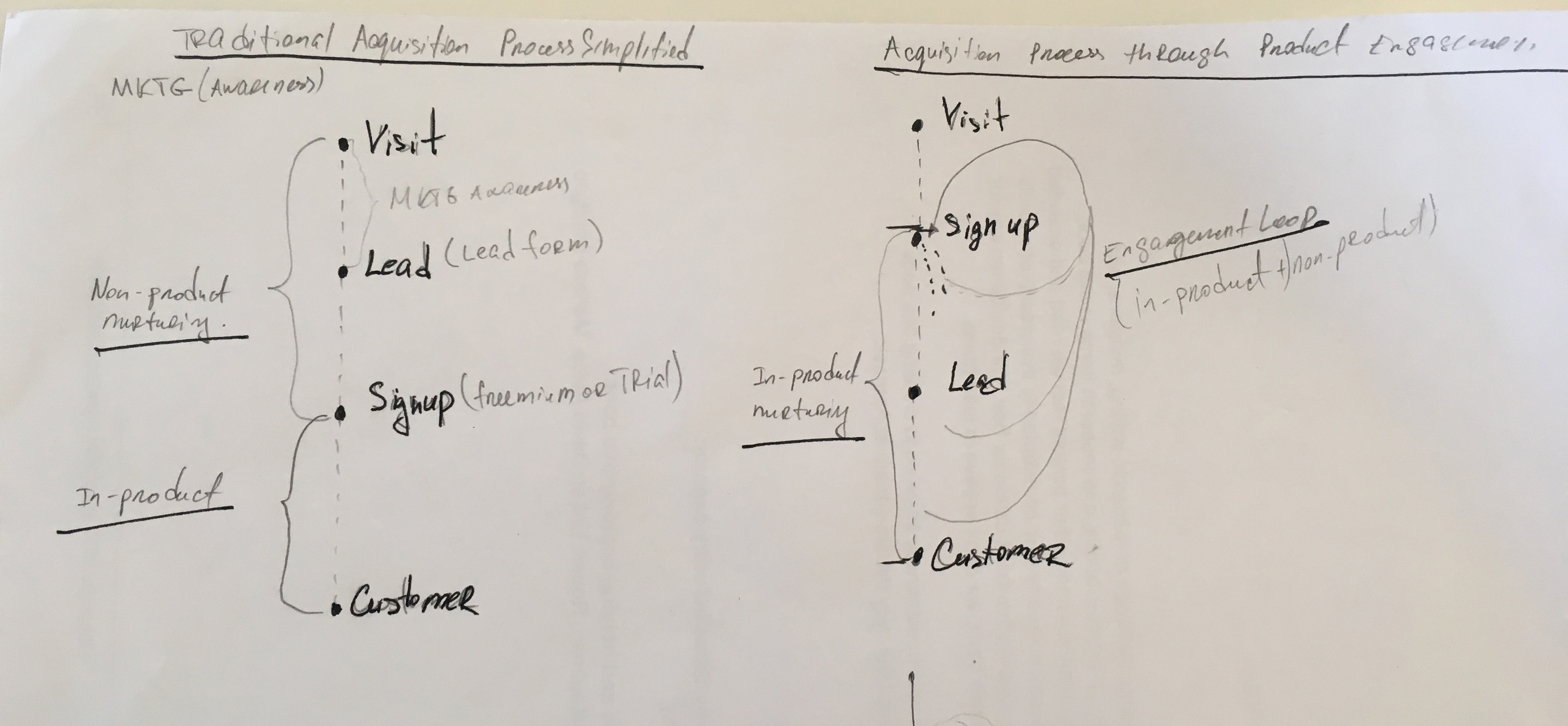
Comparing customer acquisition models
7.3 Diagrams / Figures
Just like examples and frameworks, diagrams and figures can clarify crucial concepts and improve comprehension. Many people are visual learners. As informative and attractive visual stimuli, well-designed diagrams and figures can also draw in readers who might otherwise just glance over the book’s content.
I’m a big believer in using visuals to clarify and explain concepts. I rarely start an article, a marketing campaign or any significant project without drawing a process on the whiteboard or a piece of paper. Every in-depth article that I have released includes at least one visual diagram (check out articles on strategic messaging, on designing marketing campaigns, on lead nurturing and drip emails, on freemium vs free trial, on customer experience in SaaS, on tracking customer acquisitions). I do not start any heavy writing until I settle on the visual representation of my story.
It’s difficult to offer advice on how to design an effective diagram or figure. I have a habit of collecting great visuals and have trained my mind to recognize what makes one diagram more descriptive and self-explanatory than the other.
Make it simple, iterate, show it to others and ask for feedback. I have learned a lot from Edward Tufte books on visual design and presentation and a few industry books such as Blueprints for a SaaS Sales Organization by Jacco van der Kooij. But most importantly, work with a great designer who can grasp concepts and direct you in the creative process.
I created about 19 graphs and figures for the Mastering Product Experience in SaaS book. Each figure and diagram was redrawn multiple times. I created more than 20 versions of some. Here are a few examples:
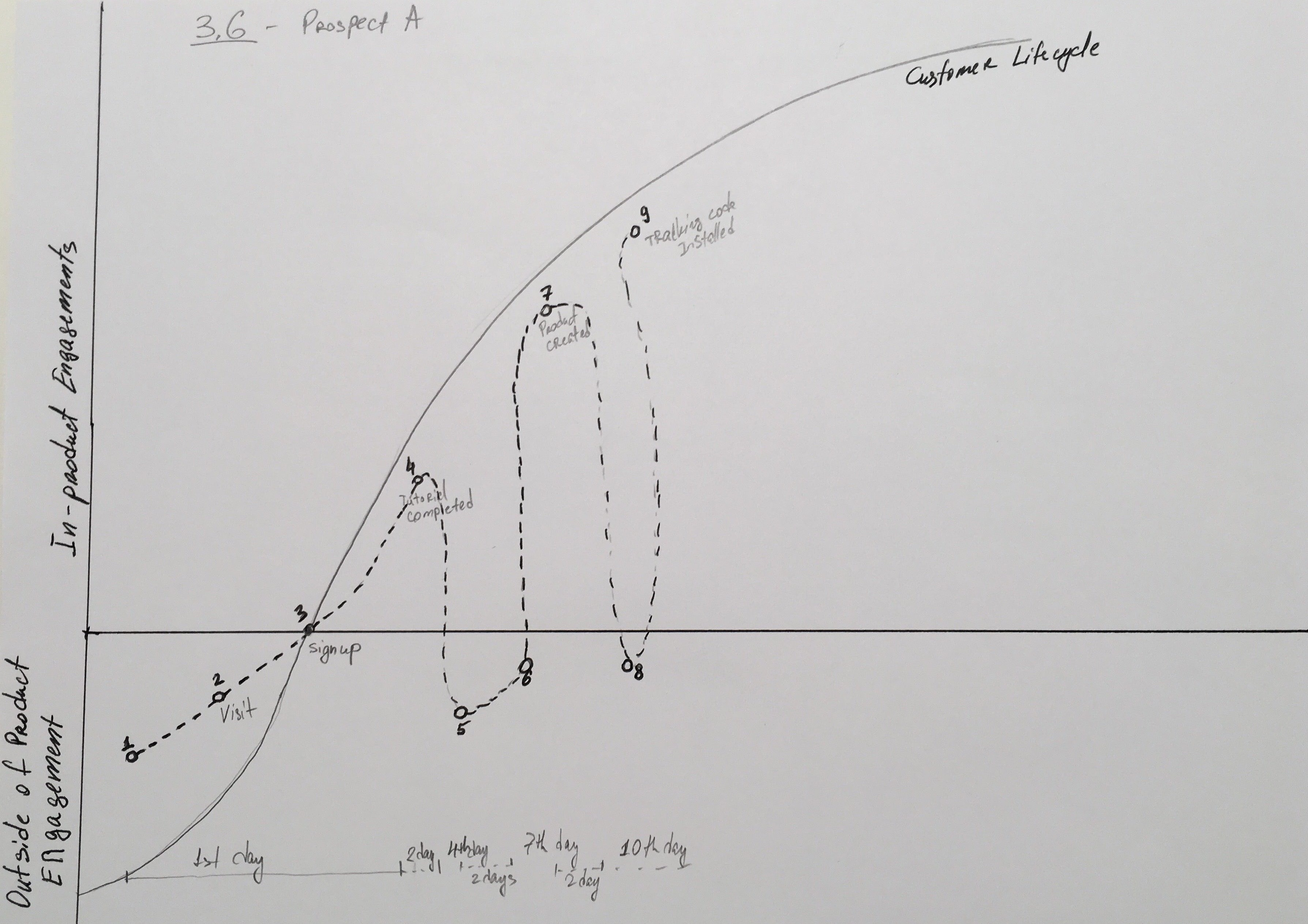
By now, you have created an outline and broken it down into parts and chapters. You have mapped examples to each chapter. You also drew a couple of diagrams and incorporated a framework to enhance readers’ comprehension. There is just one last exercise you must go through before starting the writing process. Let’s talk about style.
8. Style
I’ve come to realize that writing style encompasses all the elements and strategies that a writer is using. However, I’ve found it helpful to think about the writing style from the perspective of:
- Voice: How do you address your readers? Is this a conversation or is it more directional and authoritative style?
- Language: What language structure do you use? What words do you use? How do you define concepts?
- Focus: Do you focus more on the broader picture or on narrow tactical ideas?
- Presentation: Do you present your ideas early or do you build anticipation?
You, as a writer, should be comfortable with your style. It should feel natural to your personality and who you are. I see little benefit in advising you to use a particular writing style. Let me instead explain how I approach writing and what style I try to follow.
The main criticism I hear is that my articles are too long. There is strong belief in the industry that people do not read long articles. We assume that the average audience is reading less and less. In a time-pressed, distracting world, our content is pared down to 500-word blog posts with 5 bullet points and a stock photo.
But, how can you describe and explain an important and sometimes complicated process in a series of small articles? My style of writing is built around the belief that to understand something, you have to look at the problem from a 10,000-foot view and under a microscope. Shorter articles and blog posts often miss the big picture or a crucial tactic that can hardly be explored and dissected in a brief 500-word post.
I prefer using a simple and conversational tone in my articles. My goal is to present the expertise and research gathered during my experiences working with many early-stage companies. I do my best not to claim to write an absolute truth and I encourage my audience to contribute to the discussion.
Generally, it’s better to use simple language. You want your audience to focus on concepts and ideas rather than on searching for words in the dictionary. My goal is increase comprehension and convince my audience to try strategies and tactics I advocate.
I analyze my writing from a broad perspective first and then drill down to the nuts and bolts. There are far too many discussions, especially in the marketing field, about new tactics and strategies without a big-picture context.
As a habit, I open my articles and other writings with a clear statement about what I want my audience to take away. The goal is to set expectations and provide reasons why readers should invest their time in a long essay that is often 10 times larger than an average blog post.
My apologies for talking so much about myself here. This is the only way I know how to discuss writing style — using myself as the example. For you, the only reliable way to create your own style…… wait for it…. wait for it….. Is to practice writing. As you write more, your style will emerge. I know this is hardly a groundbreaking idea. Generally your style should make your readers:
- Read with ease
- Enhance comprehension
- Make them feel smarter
So, the pre-production part of your book process ends with a clear understanding of your story, outline, examples, frameworks, and, of course, your writing style. Next we will talk about actually writing.
Related books:
- The Sense of Style by Steven Pinker
- The Bedford Reader
Part 3: Production: Writing Process
“If you can’t explain it simply, you don’t understand it well enough.” - Albert Einstein
9. The Writing Process (tips and hacks)
Imagine skipping all the previous steps and starting directly with writing. How frightening is it to have an empty document in front of you? The chances are high that the task of writing an industry ‘how-to’ would be overwhelming, if not impossible. Hence, all the steps that we went through thus far will improve your productivity and the quality of your final product.
A clear outline mapped to examples and diagrams should stimulate your creativity enough to start the writing process. Let’s discuss writing from the both organizational perspective (i.e., how you organize your day and your writing process) and the tactical standpoint (techniques to improve the writing quality).
9.1. How to become a more efficient, effective writer
Since writing never comes easy to me, I experimented a lot to become a more effective writer and to efficiently use my time. The biggest challenge when it comes to writing is the process of transforming abstract ideas scattered in your mind into a coherent chain of logical arguments that drive the main idea. Great writing zeroes in on the right angles of the story, uses relevant evidence, and focuses readers on the most important parts of the story. Good writing is difficult; great writing is tremendously hard. That’s why great writers command such great respect.
The writing process is ‘deep work’, an activity performed in a distraction-free concentration that pushes your cognitive abilities to the limit (read Deep Work by Cal Newport). I admire someone who can work on important tasks at the local coffee shop. But I’m highly skeptical that you can perform at your optimal level, using all of your cognitive abilities, when you are surrounded by distractions.
Furthermore, it seems suboptimal to perform any kind of deep work while listening to music. Maybe listening to music while performing certain “shallow” work, such as creating a report, doesn’t hurt productivity. But I don’t buy the argument that people are different and for some music can be complementary to deep work. There is either confusion about deep work or an overestimation around individuality and individual preferences.
As with many kinds of deep work experiences, writing is more effective in a state of flow (read Flow: The Psychology of Optimal Experience by Mihaly Csikszentmihalyi). The flow state keeps a person fully immersed and energized in the process of an activity. To get to this highly efficient state of mind, one has to limit all the distraction. With every distraction, your mind must reinvest its energy to flex its cognitive muscle and arrive at or return to the optimal stage. It takes me 10-20 minutes to quiet my mind and warm up to the highly demanding task. But that time will be wasted if you are distracted ten minutes into your writing and have to switch back to the deep work at hand.
There are tons of materials about how to work deeply and improve the flow in your work environment. Let me share some of the tactics I found helpful after some experimentation.
Start writing early in your day
Surely, you have heard this before. However, I can’t stress enough how much I was able to raise my productivity when I started scheduling my writing earlier in the morning. While writing the Mastering Product Experience in SaaS book, my goal was to begin my first writing session between 9:159:30 am. I also meditate daily, which helps quiet the mind.
Limit distractions
My office space is always optimized for work. This means that I keep my desk clean and sparse, which I "a quiet" office is preferable to noisy, crowded coffee shop.
Turning off and storing your phone away from the desk helps prevent habitually and frequently checking your phone.
Quit all messaging and notification apps that can distract you.
Wear earplugs or noise-canceling headphones to limit any noise that can set your mind wandering.
Warm up
Just as you need a good warmup before a challenging practice or physical exercise, your brain needs a cognitive warm-up. My favorite strategy is to spend the first 10-15 minutes of each writing session reading what I wrote previously. If I want to write more creatively on a topic that has nothing to do with my previous writing session, I would read a book instead of reading what I wrote before. The reading session in the warm-up is a little different from a regular reading process because you’ll focus on style and language rather than the topic.
Create a timetable
You can divide your deep work into uninterrupted work and break sessions. Most of use are more productive and creative the earlier we work in the day. So it’s preferable scheduling longer work sessions earlier in the day. I use a variation of the following routine:
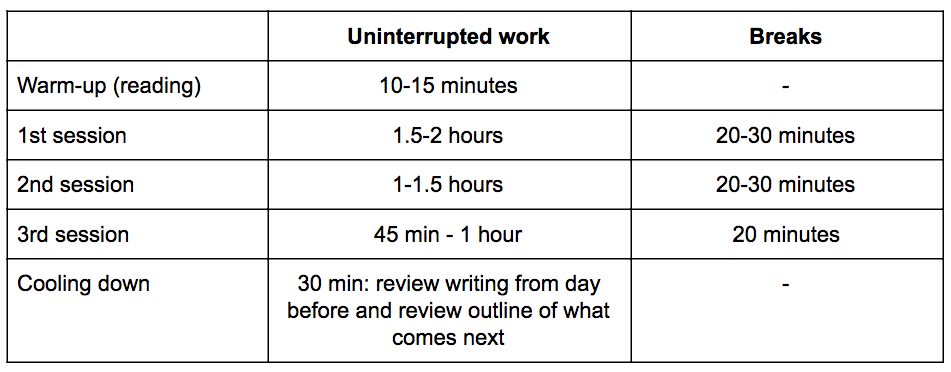
Notice that the first uninterrupted work session is longer than the second and the second is longer than the third. This is by design to optimize your effectiveness. The total uninterrupted work time ends up between 3.5-4.5 hours. If your uninterrupted work was fully engaging and challenging, it is unlikely you would be productive longer than 4.5 hours in a day. Perhaps you possess a special skill that allows you to push yourself further. However, unless we are talking about some sort of performance enhancements, it’s unlikely you can sustain an energy level required for deep work day after day without breaks.
Take the right kind of breaks
Taking breaks is critical but taking energizing breaks is more crucial. An energizing break can include walking outside (by far my favorite way to regain cognitive muscle), meditation, or a quick 30-minute nap. Frequently, a quick nap after the second or third session on a particularly challenging day can bring your mind back to full strength (Einstein was famous for his middle-of-the-day naps; test it for yourself).
Some days will be more challenging than others and if get you stuck in your writing session, take a reading break. It can distract your mind while sparking ideas for how to solve your writing challenge.
Keep a notebook next to you at all times
Your brain will be overwhelmed during the writing process. It usually takes a while until the raw,abstract ideas take shape. Often good ideas will come to you while you are walking or when reading something. Keep your notebook next to you and record ideas so you can evaluate them the next morning during your writing session.
On diet and sleep
A good night of sleep and adequate diet also impact your productivity. I have noticed increased effectiveness after eating an unusually large breakfast and skipping lunch, and then eating dinner only after 5 pm. A quick snack of dried fruits or nuts are enough to fight hunger till 5 pm. This eating schedule increases my productivity during the day because it helps me avoid a post-lunch crash.
Many reliable sources and studies can help you understand how to improve your deep work and performance in general. Try different variations and settle on what works for you.
And don’t forget that reading more high-quality writing will not only help you recognize good writing but also will make you a better writer.
Let’s move to specific techniques for improving your writing.
9.2. How to improve your writing
You can improve your writing by applying tactics designed to help you write more clearly and convincingly.
Define, don’t assume
Unfortunately, the industry is filled with noise. It is not always clear in public rhetoric what people mean using a certain word, industry terms, or jargon. Defining important concepts throughout your book will ensure that you and your readers are aligned on fundamental information on which you can build your arguments. Definitions help establish a common vocabulary between a writer and a reader.
Our Mastering Product Experience in SaaS book includes over fifty definitions that were later included in a separate glossary.
Point of view
An author must have a point of view to make their content worthwhile. You have to take a position. You have to disagree. You have to argue. Otherwise, why do you want to write a book? What are you contributing to the conversation? And why would anyone care? In short, you have to develop a strong point of view and put a stake in the ground.
Personal experience
Writing an industry ‘how-to’ requires expertise. Your personal experiences, when relevant, can enhance your story and sketch a clear path for the reader toward your ideas and beliefs.
Use synonyms
For those of us who aren’t natural writers and lack a rich vocabulary, synonyms can tremendously improve the quality of our writing. As a habit, review your writing and notice what words and phrases you are overusing. Then create a list of synonyms and alternatives. You will not only enrich your writing and improve comprehension but will get more from your relationships with editors.
Compare and contrast
Comparing and contrasting examples, evidence, and processes will yield more precise explanation. Comparing similarities and contrasting differences help writers explain and evaluate ideas and concepts.
Process analysis
Process analysis is central to writing a how-to book. Before you can write a step-by-step process, you must fully grasp it yourself. Don’t forget that as a writer, you are prone to the curse of knowledge, a difficulty imagining what it is like for someone else not to know what you know (read more on this in The Sense of Style by Steven Pinker).
When describing a process, don’t forget to evaluate not only the process steps but when the process should be applied and what preparations are necessary prior to starting the process. The steps should be complete, specific, and descriptive.
Your readers should be able to replicate the process and reach predictable results. Otherwise, the writer has failed at describing the process clearly.
Arguments and persuasion
Avoiding logic fallacies improves the persuasiveness of your writing. Stay aware of using the most common logical fallacies, such as wrong cause-and-effect relationships, overgeneralization, oversimplification, and false analogies, to name a few(more on this in The Bedford Reader).
Address potential criticism
Regardless of where you stand on an issue or topic, you can’t avoid criticism. So don’t attempt to avoid criticism by adopting a neutral stance -- you need a point of view. While you can’t foresee every angle from which you might be criticized, you can predict the most common counter arguments. The best approach is to proactively address the most common challenges to your argument.
Master transitions
The next time you read an engaging book, notice what makes it interesting and easy to follow. Great writing uses effective transitions to connect different premises and arguments that lead to a conclusion. Jumping from one idea to the next can cause a dissonance in the reader’s mind. On the other hand, a great transition explains to readers how two ideas connect, and prepares readers for what comes next.
Sources: Be inclusive, summarize, paraphrase, and quote
It’s smart to reference other work within your book because it helps validate your arguments. Plus, when other authors see that you reference them, they are more likely to share your book with their audience. In turn, your content reaches a broader audience.
During the writing process, you can incorporate research by summarizing and paraphrasing the research’s main idea. In cases where you want to preserve the meaning intact, quoting your sources might be better. Just as you want people to respect your writing by mentioning and referencing it properly, you want to give credit to those who have done work on this topic before you came along.
Recap with tips, takeaways, and summaries
We need to hear ideas a few times before we can recall them. It’s helpful to include takeaways or summaries at the end of each chapter to refresh the reader’s memory. Include call outs throughout your book highlighting tips, case studies, and other main points to draw the reader’s attention without interrupting the story’s narrative.
10. Review and editing process
How do you keep going and accelerate your momentum while writing a book? It’s as easy and as difficult as writing itself. Even the most amazing writer doesn’t end up with a perfect first draft. Don’t let the first difficulties demotivate you.
When I first started writing, I was trying to perfect each section before I moved on to the next. Chasing perfection caused me to get stuck on small parts of a section or chapter for days. This process wasn’t efficient and I soon tested and implemented a new strategy that I now use regularly.
To ensure good quality, work with at least one editor and keep a shortlist of early reviewers who can provide feedback.
The flow of writing, reviewing, and editing
Step 1: Getting your draft ready for the editor
Before showing your draft to the editor for the first time, it needs to go through four stages:
-
Create/review an outline
The day before you intend to write a certain section, review or create a simple outline. Refreshing your mind with the main ideas allows them to brew and marinate before you start the heavy lifting. -
Write a raw draft
The first session of the day is focused on the hardest part -- writing the first draft. It doesn’t have to be perfect and it shouldn’t be. The goal is to get down the whole section. Even if it’s just bunch of incoherent thoughts and ideas, document them. Put your ideas on paper to the best of your abilities but don’t stress about perfect wording, mistakes, typos and so on. Just follow your outline. -
First rewrite
The next day you will move to writing the next section for the first time. This is when you will use your second scheduled session to go back and rewrite the raw draft of the previous section. -
Second rewrite
During the second rewrite, you can polish your content and focus on better wording, using synonyms, and adding transitions and summaries. Then the draft is ready for the first review by an editor. Again, you don’t need a perfect draft at this stage. It’s okay if there are still issues with it as long as you’ve captured most of the content and ideas. Pass it on to your editor who can help you evaluate your writing.
The table below outlines the flow of the writing process. Previously, we discussed a timetable that had three primary sessions reserved daily. The first session of the day should be focused on the most difficult task at hand -- writing a raw draft. The second session can be used for the first rewrite and the third for the second rewrite. You can incorporate outlining of the next day’s section or chapter into the writing sessions later in the day.
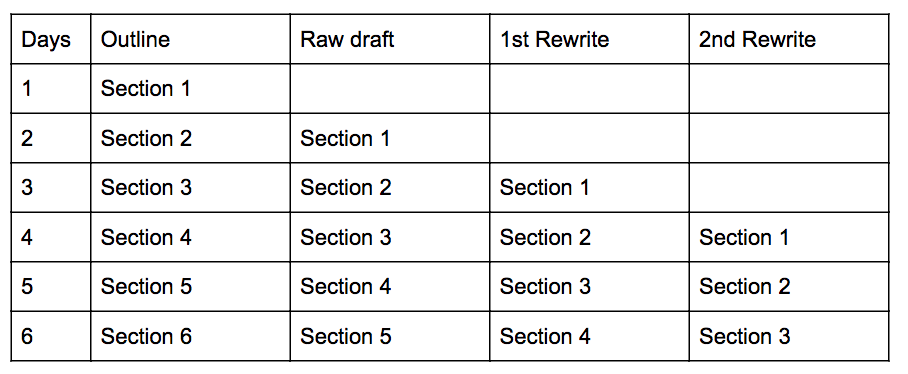
If another process works better for you, use that. The main idea is to structure your time so that your day consists of first writing the raw draft, then rewriting your previous sections, and then looking at an outline of what comes tomorrow.
Step 2: Editorial review
The role of the editor in the writing process can hardly be overstated. I have worked with over 20 different editors in the last few years. And I was fortunate to work with two amazing editors (Stephanie Tilton and Steve Schaefer) who were instrumental in helping create our Mastering Product Experience in SaaS book. The writer-editor combo reminds me of the athlete-coach dynamic. An editor is a coach guides a writer through the process of creating a decent copy.
How do you pick an editor?
This is a topic for another post but there are two things that writers should look for. It’s a given that your editor must be a great writer. However, when you are writing an industry ‘how-to’ book, it helps to have an editor who not only can write but can also assess the quality of your content. This is not a novel that everyone can understand. Your editor has to have a certain level of relevant industry knowledge to be fully effective.
Second, the more you work with your editor the more he or she should be attuned to your style, and voice, and the language you use. You don’t want your editor to destroy your voice and point of view. Great editors feel the writer and adjust their editing style to fit the writer. And, of course, the best editors raise the right questions and can step in when ideas and concepts should be further clarified. As I said earlier, the same qualities that make one a great coach make a great editor.
Step 3: Rewrite. Edit. Review. Repeat.
In general, a good rule of thumb is to go through editing twice before showing your content to a shortlist of reviewers. Ideally, you want to show your draft to a total of about 15 people. Reviewing a book draft is a time-consuming exercise so try to find people from your network who can and will invest the time. If you mentioned someone’s work in your book, reach out and ask for the favor of them reviewing your book. Your mentor, former boss and coworkers are also excellent candidates.
There is nothing like the first impression so give your draft to five people for the first round of reviews. After you review their feedback and go through another rewrite-editing combo, show your revised draft to the first five people and to five new people. Repeat this process for the third round of reviews (refer to the Product Stage diagram below).
How do you ensure high-quality feedback from reviewers?
To get quality feedback, you must ask the right questions and give detailed directions to the reviewers. “It’s great” or “it’s bad” is not going to help you improve your copy. When you send your content for review ask your readers to do the following:
- Highlight things that you like. What are the three items you like the most out of the whole copy?
- Highlight content that you disagree with. Why do you disagree with it?
- Highlight things that are confusing. Why are they confusing? What questions aren’t answered?
- What can be added to the copy? Can you share an example from your experience that fits a particular statement?
- What is the one thing that you learned?
- What is the one thing that you would consider implementing?
This set of questions improves your chances of receiving valuable feedback. The readers will be reminded what to look for and how to provide actionable feedback.
Tip: Don’t give equal weight to all feedback. While it’s crucial to get as much feedback as possible, don’t forget that you own the story; you have the big picture in mind and it’s up to you to decide what feedback needs to be implemented and what should be disregarded. You can’t please everyone! At the end of the day, the writer has to decide what goes in and what stays out.
After three rounds of reviews, five round of edits, and six rounds of rewrites you have your final draft (refer to the diagram below). Congratulations! That was easy, isn’t it? Just kidding… But you can see the finish line and this fact should raise your energy levels.
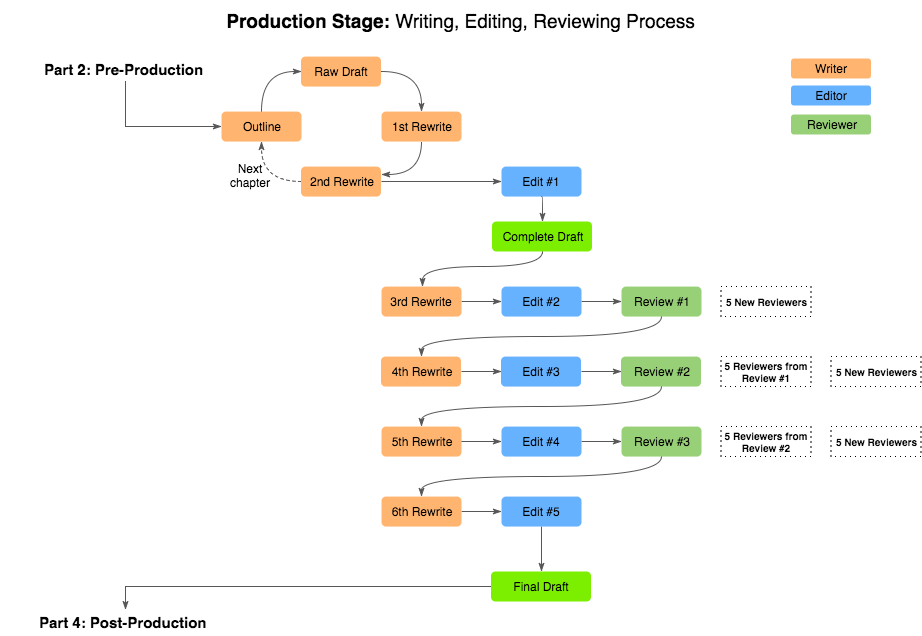
Part 4: Post-Production: Design & Layout
In filmmaking, post-production starts right after shooting is complete. Similarly, the post-production stage of publishing an industry ‘how-to’ book starts with once you’ve completed your final draft. The final draft includes all the ideas, concepts, examples, and visuals that you want to include in the final version.
It’s not necessary to have all diagrams well designed at this point. You can get away with just a hand drawn visual in your final draft as long as it represents the final structure. The post-production stage is the time to polish your final draft and fine-tune the details. This is also when the final round of editing and professional proofreading is done. These reviews are focused on spotting small typos, ensuring a consistent layout, and listing references according to a selected style guide.
Let’s quickly review a list of post-production items.
11. Finalizing title, chapter titles, etc.
It is time to revisit your decisions when it comes to the book and chapter titles. Needless to say, the book title sparks a reader’s initial interest and often influences the decision to read it. A great title captures people’s attention and entices someone to read your book. Obviously, accounting for likely terms people will search on in Google can significantly impact your choice of title.
After a few months of writing, with the topic and main concepts brewing in your brain, you should be able to come up with engaging title options. An editor or a early reviewer might say something that sparks an idea. Keep a record of every title idea that comes to mind over the course of your writing.
Tip: Create a list of at least 20-30 different book titles. It’s fine if some are variations with just a difference of one word. In a book title, every word matters.
It’s worthwhile to review your chapter and section titles as well. Often the final content of the chapter shifts the focus and angle, requiring an updated title.
12. Designs and visuals
Work with a designer to sketch the final diagrams, figures, and tables. It’s very easy to miss a small detail or overlook inconsistencies in colors, fonts, etc. from one diagram to another. We were lucky to work with an amazing illustrator (Verena Tam) who transformed my hand drawn graphs and figures into state-of-the-art designs.
Another question that needs to be answered is how to number the diagrams and tables. Do you number all diagrams in the book in sequence? Or do you start numbering from the beginning in each chapter? There is no right or wrong answer here; one might works better depending on your content and how many visuals you are including.
Tip: Create a glossary section at the end of your book. It will help readers find and refresh their minds on important definitions.
13. Final reviews
Your editor does not handle the final editing and proofreading. It is best to use a professional editor with publishing experience. When our final draft was ready with complete copy and designed visuals, we found a great company for final proofreading.
In addition to proofreading, publishing services include listing references properly. After your final review is complete, all content and designs must be locked. This is it. Nothing can or should be changed from this point on.
14. Layout (digital / print)
A designer puts the final touches on your book. The content needs to be laid out for every page. The cover of the book has to be finalized. Laying out of the book is not an easy task and mistakes can happen, so bring in a few people to review the final layout.
Digital and print layouts have to be done separately. So if you intend to print a hard copy of the book, you have to create a separate layout. A good designer and illustrator can walk you through this process.
Tip: Include an acknowledgement section in your book. Only once you go through the entire process of writing and publishing the book will you grasp the magnitude of the work involved. You should acknowledge every single person who helped you in any way. Sometimes even a small comment from a reviewer can drastically change the course of the book.
Remember: ALWAYS, ALWAYS, ALWAYS list sources and references because you want people to reference your work too! And always acknowledge the contributions of others.
15. Hard copy
I could write a whole other article on how to self-publish a hard copy of a book. You will have to worry about ISBN numbers and find either a local publisher or a self-publishing service.
Part 5: Distribution (and Promotion)
An article about writing an industry book would be incomplete if we didn’t discuss distribution. Even great content has to be found, so you need to create a distribution plan.
Create a landing page
I’m big believer in freely accessible content and that’s why I advocate for publishing your complete book online. Unless you intend to sell the book, consider providing the full version online for free. The fewer barriers for people to access your content, the greater number of people will read it. Regardless, whether you want to publish the full book online or put it behind a lead form, you need to create a great landing page to showcase the content and entice people to want to read your book.
Events and speaking engagements
If you have budget to host a small industry event, strongly consider doing this. Even if your resources are limited, find a meetup or industry event where you can present and speak to summarize the book content.
Social media posts
Create and schedule social media posts with summaries, quotes, and visuals from the book. Use relevant hashtags and drive the audience to the book landing page or a book web version.
Release summary articles for the book and chapters
Write chapters and sections and publish them as blog posts or articles linking back to your book. Reuse the content that you heavily invested in.
Partnerships
Partner with companies that sell to the same target audience but aren’t competitors. Syndicate your content with partners and if you request email addresses in exchange for downloading the content, both you and your partner company can share these for lead generation purposes.
Newsletters
Find industry newsletters and figure out a way to promote your book in these.
Industry influencers
Connect with industry influencers (especially with those you mentioned in your book) and ask them to review your book. Additionally, provide options for them to spread the message by retweeting your Tweets or sharing your Linkedin update.
Content distribution is a large topic on it’s own; I will cover it in more detail in another article.
Summary
“Brevity is the soul of wit”
Unfortunately, this article ended up much longer than initially planned. However, my goal was to provide a comprehensive plan of how to write an industry book from start to finish. Bookmark this page and come back to it when you need guidance.
I hope you found this article helpful; if so, please recommend and share it.
Before you go, let me give you a few final tips:
- Keep a notebook with you at all times during your writing process. You never know when an interesting idea will pop up into your head. You don’t want to miss it.
- It wasn’t until I was in my mid-twenties that I realized how crucial regular reading is to your success, creativity, critical thinking, productivity, and state of mind. While writing something meaningful, ensure you read daily. It will boost your productive writing and your creativity. Reading critically takes a little more effort but during writing periods, it’s a worthy investment.
Books:
- The Story by Robert Mckee
- The Sense of Style by Steven Pinker
- The Elements of Style by William Strunk and E.B. White
- The Bedford Reader by X.J. Kennedy and Dorothy M. Kennedy
- Bird by Bird: Some Instructions on Writing and Life by by Anne Lamott
- The Storytelling Edge by Joe Lazauskas and Shane Snow
- Everybody Writes by Ann Handley
- Deep Work by Cal Newport
- The Flow by Mihaly Csikszentmihalyi
- Peak Performance by Brad Stulberg and Steve Magness
If you like this article please recommend and share.
Follow me on Twitter, Medium, Quora, Instagram, connect on Linkedin. Join my Telegram channel - Marketing Journal - to discover interesting articles, books, and resources on marketing, product growth, startups, and SaaS.
Send me email with comments and questions: myk[at]myxys.com.
Read more:
- How To Track Customer Acquisitions: Customer Lifecycle, Sales Funnel, and Content Strategy
- Freemium vs Free Trial vs Hybrid Customer Acquisition Model in SaaS: How To Develop a Customer Acquisition Strategy
- How to Design Marketing Campaigns: The Importance of Market Segmentation
- Strategic Communication: How to Develop Strategic Messaging and Positioning


